The Pure Water Occasional for August 4, 2014
In this first-in-August Occasional, you'll hear about pharmaceuticals in sweet potatoes, microsystin and cyanotoxins in Toledo, a strange new lake in Tunisia, a big water main break at UCLA, shocking pollution at St. Louis, MI, and warps in Greenland's ice sheet. Learn about the disheartening decline of National Garden Hose Day, the German beer industry's war on fracking, and beef industry's war on water. Learn how we are all Californians, what's inside a reverse osmosis tank, how to put air in it, which is the deadliest animal on earth, and why voluntary water saving programs don't work. Then there is caviar, manure runoff, paddlefish, the Hose Blast, Gafsa Beach, the Tulsa Tugboats and, as always, there is much, much more.
The Pure Water Occasional is a project of Pure Water Products and the Pure Water Gazette.
To read this issue on the Pure Water Gazette's website, please go here. (Recommended! When you read online you get the added advantage of the Gazette's sidebar feed of the very latest world water news.)
Root Vegetables Irrigated With Treated Wastewater Can Take Up Certain Drugs
Wastewater Reuse: A field study shows that carrots and sweet potatoes accumulate an anticonvulsant drug and a drug metabolite at potentially unsafe concentrations
by Janet Pelley
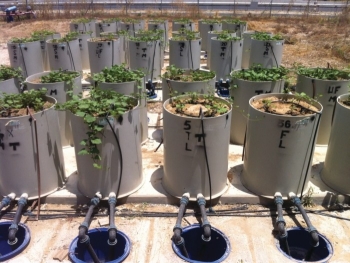
In an experimental plot, scientists in Israel irrigated sweet potatoes with treated wastewater to determine if the vegetables accumulated pharmaceuticals from the water.
Faced with dwindling sources of freshwater across the globe, growing numbers of farmers are using wastewater to irrigate food crops. This wastewater, however, can contain trace amounts of pharmaceutical compounds excreted by people, so scientists want to know how much of the drugs make it into plants and onto dinner plates. A new study of root vegetables irrigated with treated sewage effluent finds that, although many drugs don’t accumulate at detectable levels, a couple can build up to concentrations that may exceed safe exposure levels (Environ. Sci. Technol. 2014, DOI: 10.1021/es5017894).
About half of Israel’s agriculture relies on irrigation with treated wastewater, and the practice is gaining ground in Africa, Asia, Mexico, and in parts of the U.S., including California and Arizona, says Tomer Malchi, a soil scientist at Hebrew University of Jerusalem. But only a few previous studies have gauged plant uptake of pharmaceuticals in a farm setting, he says, and these did not estimate the health risks to people nor look at drug metabolites.
Malchi and his colleagues, including Benny Chefetz, decided to track 14 common pharmaceuticals and two metabolites of one drug in irrigation water and then in the edible parts of crops. The scientists grew sweet potatoes and carrots outdoors in 0.5-m3 plots irrigated with the same water used by local farmers: treated wastewater from the city of Kiryat Gat, Israel. They measured concentrations of the compounds in the irrigation water, soil, and plant tissue using liquid chromatography/mass spectrometry. In the two vegetables, the scientists did not detect any drugs except for caffeine and the epilepsy drugs lamotrigine and carbamazepine. These nonionic organic molecules cross cell membranes easily and thus are more likely to be taken up by plant roots. They also found 10,11-epoxycarbamazepine, a metabolite of carbamazepine. Concentrations of the compounds ranged from 0.013 to 4.130 ng per g of the vegetables’ fresh weight.
Malchi and his colleagues then determined the threshold of toxicological concern (TTC) for the compounds, a method that the European Food Safety Authority uses to establish safe levels in food of chemicals that lack firm toxicological data. The method assigns compounds to one of four levels of potential toxicity, each of which establishes an acceptable daily consumption value, above which there would be a possible risk to human health.
On the basis of the concentrations detected in the vegetables, “an adult would have to consume hundreds of kilograms of sweet potatoes or carrots from our study daily to reach the TTC level for caffeine or carbamazepine,” Malchi says. For 10,11-epoxycarbamazepine, a child would need to eat 90 g/day of sweet potato leaves, a popular food in Asia and Africa, to exceed the TTC level. But that same child could surpass the TTC level for lamotrigine by eating just half a carrot in a day.
Malchi says the data suggest the need for toxicological studies of these detected pharmaceuticals “to determine their exact level of toxicity, so that acceptable levels in treated wastewater for irrigation can be established.”
The study is likely the first time that the TTC has been used to assess health risks from pharmaceuticals in food crops, saysChad A. Kinney, an analytical chemist at Colorado State University, Pueblo. He thinks it’s a good approach for screening substances for further study. The study also suggests the need to look at metabolites—not just parent compounds—when determining the risks of using treated wastewater in agriculture, Kinney says.
Source: Chemical and Engineering News.
Pure Water Gazette Fair Use Statement
2014 Garden Hose Day "disappointing"
The 2014 National Garden Hose Day, celebrated August 3, was, according to national event chairman Bob Lewis, "disappointing." Lewis said that this year's response to the event fell far below expectations. Most would simply say that the event was a big flop.
The National Garden Hose Day has experienced consistent, enthusiastic annual growth since its inception, but the 2014 Garden Hose events were poorly attended in most cities around the US.
In addition, sales of products related to the celebration fell off sharply from last year. One marketing expert said. "I think we overestimated the commercial potential of the event. For one thing, garden hose sales are flat nationwide. There are simply too many garden hoses out there, and they last a long time. When a family has three good garden hoses, it's hard to sell them another one. Let's face it: garden hose innovation is difficult. You can't sell a hose because it has a fancier operating system. Drought in some areas has also driven sales down. If you can't water your lawn, you don't need a spiffy new garden hose."
The slump in event attendance has also been blamed in part on drought and water shortage in many parts of the country. People do not get excited about recreational events that center on water when water is being rationed. Consequently, one of last year's most popular events, the Garden Hose Blast (see picture below, from last year's contest in Des Moines, IA), was cancelled to save water. "Not having the Hose Blast," Lewis said, "definitely hurt ticket sales. The Hose Blast was really a crowd pleaser."

Enthusiasm for National Garden Hose Day may also have been dampened by unexpected attacks on the celebration by several conservative talk show hosts whose motives were unclear. It has been suggested that the totally secular nature of Garden Hose Day as well as its lack of patriotic significance have made it unpopular in certain circles. Event Chairman Lewis said, "Garden Hose Day is mainly just about about having a good time. Some Americans seem uncomfortable about having a good time unless they can find justification. If Moses had owned a garden hose, or if Ben Franklin had flown his kite with one, Garden Hose Day would be an easy sell."
Event Highlights
The Tulsa Tugboats, last year's third-place finisher in national garden hose pull competition, this afternoon bested their arch-rivals the Wichita Whippets in the 2014 National Garden Hose Pull championship match in Minneapolis. Although the Whippets had a distinct weight advantage, the Tugboats outlasted them to take the title. The event favorite, the Cleveland Pack Mules, were eliminated early in spite of a stellar performance from star puller Paul Browning.
Water Treatment for Microcystin
by Gene Franks
This morning's water news (August 3, 2014) is filled with stories and pictures of the episode of microcystin contamination in the city of Toledo, Ohio water supply. Officials in Toledo warned residents not to drink the water and cautioned that boiling (a frequent emergency strategy for bacterial contamination) would only make things worse. This is no small issue since it leaves 500,000 people without drinking water.
As usual, bottled water is the quick fix for supplying potable water, but providing bottled water for half a million people is no small task. The picture below suggests that bottled water was in short supply.

I watched several news reports and read a few news releases. Not one mentioned that home water treatment devices owned by the residents might be used.

Microcystin is one of a large number of toxins that are grouped under the name of cyanotoxins, and microcystin itself exists in several forms. It all starts with blue-green algae, also called cyanobacteria, which are microscopic aquatic organisms. They are ancient creatures that produced Earth’s earliest fossils. Some blue green algae (often identified as "pond scum") are important sources of human nutrition but others put out toxic ingredients called cyanotoxins that are harmful to humans. Algae contamination of lakes has become very common because of the overuse of fertilizers.
![algae[1]](https://ymlp.com/https.php?id=www.purewatergazette.net/blog/wp-content/uploads/2012/09/algae1.jpeg)
Green Slime that plagues Great Lakes results mainly from fertilizers used by big agriculture.
According to Water Technology magazine, "Algae-containing water can be swallowed, can contact the skin or is inhaled in aerosol-like droplets while swimming or showering. Cyanotoxins can cause gastrointestinal and lung ailments; allergic responses; skin and eye irritation; liver damage; tumor growth; and neurotoxic (nerve) reactions. Effects of long-term consumption uncertain."
Advice on water treatment for cyanotoxins from a web search ranges from the overly complex to the downright simple minded. Bulletin board advice suggests "popping some activated charcoal to help neutralize these toxins" and taking milk thistle to protect the liver. At the other extreme are a doctoral dissertation long on theory and short on practical advice and a technical paper on "Removal of microcystin-LR from water by polymers based on N-vinylformamide structure." Another study features "a new kind of low-cost syntactic adsorbent from bamboo charcoal and chitosan" for use in impoverished regions. Yet another describes an experimental project with a " hollow fiber microfiltration pilot plant (2–4 m3/h)" in which " high removals of cyanobacteria (98%) and total algae (99%) were obtained." Not very helpful for the home owner who wants protection from microsystin.
The WHO and the EPA offer advice aimed mainly at public water suppliers, not individuals. In both cases, the treatment recommendations are broad and generalized. The EPA, for example, notes the effectiveness of chlorination and potassium permanganate to control the organism but warns of problems with side effects. Likewise, the possibility of using flocculation and subsequent filtration has its pros and cons. Powdered activated carbon can be used to remove toxins as can granular activated carbon. "GAC filters are effective in removing microcystins if they are properly replaced or regenerated when total organic carbon breakthrough is high. Usually, higher concentrations of activated carbon are necessary to effectively remove toxins; repeated treatment may be needed to totally remove the toxins completely." The EPA also notes the effectiveness of UV for controlling cyanotoxins but says that very high doses are needed.
These, as mentioned, are strategies for city water departments, not homeowners. In general, they are not especially practical for city water suppliers. Carbon beds large enough to effectively remove toxins of this nature are not used by most municipal suppliers.
Here's what Water Technology Magazine says about treating cyanotoxins:
Activated carbon is effective and can resolve cyanobacteria-caused taste and odor issues. Reverse osmosis (RO), nanofiltration and ultrafiltration will remove/reduce single-cell cyanobacteria, and may also help reduce cyanotoxins. Disinfection methods (such as chlorination) may kill cyanobacteria but not eliminate the cyanotoxins they release.
Finally, the search for microsystin with a variety of keywords got one persistent ambulance chaser ad for ceramic filters. The linked site itself does not discuss microsystin, but the ad implies that the ceramic filters advertised will take care of the problem.
What I would do if I lived in Toledo
What conclusions should we draw from this in regard to common home water treatment devices?
Although untrafiltration, microfiltration, and nanofiltration devices have been used with some success to treat microsystin, these are not commonly used in homes. Reverse osmosis units, however, are common, and RO has been shown to be 95% plus effective in this area. If I lived in Toledo, I would trust my undersink RO unit. RO combines the advantages of an extremely tight membrane and a slow pass through at least two excellent carbon block filters. Keep in mind that the same reservations that apply to using RO in standard "boil water" situations also apply here: While the contaminants in question are too large to pass through the RO membrane, the device itself was not designed for long-term "sanitation" of water that is infested with dangerous bacteria. Live organisms can grow around o ring seals. But, on a short term basis, I would trust my RO unit.
Ultraviolet systems used in domestic water treatment are not potent enough to inactivate cyanotoxins.
Chlorine, in high enough doses, can control cyanotoxins, but the dosage used by public water supplies is too low. Chloramine is not effective against cyanotoxins.
I can't find evidence that would make me trust a ceramic filter in this situation, but a good ceramic filter with a carbon core would probably produce safe water.
To wrap it up, I would drink water from my home RO unit if I lived in Toledo, but I would be reluctant to recommend that others do the same. As they always say, "More research is needed."
News Items for the week ending August 4, 2014
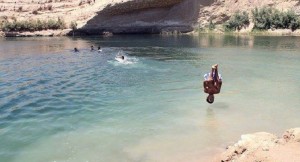
Gafsa Beach in Tunisia
A mysterious lake has appeared as if by magic in Tunisia. The lake, which covers 2 1/2 acres and is 32 to 59 feet deep, was discovered three weeks ago and already has its own Facebook page showing people enjoying the water, but officials are at a loss to explain its origins.
Pennsylvania does little to force farmers to manage manure runoff. Pennsylvania's manure management rules have been on the books since the 1970s, and larger farms have been held to them. But many small Pennsylvania farmers are unaware that the rules exist, according to farmers, conservation agents and environmental advocates.
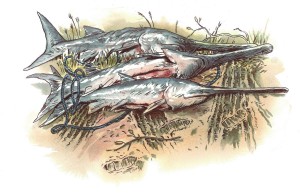
Caviar’s last stand. No one knows how many paddlefish once swam the Missouri and Mississippi watersheds, but it’s certain that the fish used to be much more numerous. Why care about paddlefish? They are humanity’s best last chance with sturgeon and their relations.
The deadliest animal on earth? Shark? Snake? Bear? No, it's the mosquito.
How Effective Are Voluntary Water Saving Programs?
Voluntary conservation measures are not reliably saving water during the worst drought to hit California in a generation, according to data from water agencies across the state. Only mandatory conservation rules, backed by a threat of fines, seem to prompt consumers to save.
California water agencies with mandatory rules alone used 5 percent less water from January through May this year, compared to an average over the three previous years, according to a Sacrmento Bee analysis of the data. Agencies with only voluntary conservation measures saw water demand rise 4 percent over the same period.
Read full details in the Sacramento Bee.
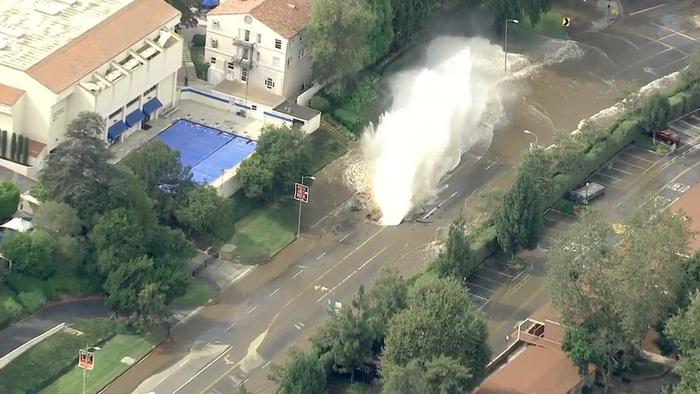
Water Main Break Floods Sunset Boulevard
The spectacular dumping of 20,000,000 gallons of water just off the UCLA campus should remind us that there are a million miles of water mains in the United States and some of these date back to the Civil War. The LA Times used the occasion to remind readers of the need for upgrading of our water infrastructure and, consequently, the need for higher water bills to pay the costs. Here is the Times editorial:
If Los Angeles leaders needed any reminders about the city's aging infrastructure and the ever-increasing backlog of maintenance, they got it Tuesday in the form of a 30-foot geyser spouting from Sunset Boulevard. The rupture of a 90-year-old water main sent more than 20 million gallons into the streets and onto the UCLA campus, flooding the recently renovated Pauley Pavilion. To add insult to injury, it spilled enough water to serve 155,000 people for a day — just as statewide restrictions on water waste took effect.
About a quarter of the city's water pipes are more than a century old and at increasing risk of failure, yet the Department of Water and Power's pipeline replacement rate is 315 years. In the wake of the Westwood break, several City Council members have called on the utility to fast-track pipe replacements and improve the reliability of the water system.
We've heard this before. After an accident, the DWP launches an aggressive schedule to repair and replace old infrastructure, then city or utility leaders balk when it's time to raise rates to continue the repairs. Indeed, the utility has already adopted a financial plan that called for investing $2 billion over 10 years to upgrade aging pipes. But the utility dropped plans for a rate hike in 2012, and a recent report shows that it has scaled back its water infrastructure goals. If L.A. wants to fix its old pipes faster than every 300 years, then the City Council and Mayor Eric Garcetti need to make a long-term commitment to funding the work and providing oversight to ensure that the money is spent efficiently. And customers will need to pay more for their water.
Higher water bills are a hard sell. Water rates have already risen 45% in the last two years simply because of the drought and the higher cost of imported water. Plus, ratepayers are being charged a special fee to repay the billions of dollars spent to cover open reservoirs and build the second-largest ultraviolet water treatment plant in the nation, all of which are required in order to meet state and federal environmental rules. But there's a cost to inaction as well. DWP ratepayers could be on the hook for tens of millions of dollars in damages from the water main break near UCLA.
L.A. is rapidly showing its age. Potholed streets, busted sidewalks, deteriorated power poles and leaking pipes are all symptoms of a city that can't afford or hasn't prioritized basic maintenance. Sometimes it takes a crisis — or a geyser — to focus city leaders and residents on the need to invest in infrastructure.

Weird warps in Greenland Ice Sheet attributed to melting and refreezing. The flat, glistening, white expanse of the Greenland Ice Sheet, stretching out across hundreds of thousands of square miles, appears placid, unchanging … boring even. But this tranquil surface belies the turmoil taking place below, at the base of the ice sheet. There, scientists have discovered sections of ice up to a kilometer thick and tens of kilometers long where meltwater has refrozen to the base of the ice sheet, setting off a dynamic process that causes the layers of ice to build up over the eons and contort into sinuous folds.
German beer industry takes on fracking. Germany’s 1,300 brewers are concerned the country’s energy needs and the introduction of fracking will collide with the business of producing some of the best beers in the world.
Birds fall from sky in St. Louis, Michigan amid massive chemical cleanup. It's startling to watch robins drop from the air, flop around and die. But the cause is no mystery to the nearly 7,500 people who live in this Gratiot County town — a toxic legacy of decades of pollution from the nearby former Velsicol Chemical site on the banks of the Pine River.
The burden of beef. A study published in the Journal of the Proceedings of the National Academy of Sciences shows that producing beef places a greater burden on the environment than, say, chicken or pork. “Comparing beef to other forms of meat that Americans typically eat, beef cattle uses about 11 times more irrigated water and produces five times more greenhouse gas emissions, and six times more nitrogen. Also, producing a pound of beef uses almost 50 times more water than growing a pound of vegetables, and about 40 times more than growing potatoes and other root crops, and about nine times more than grains.” The article features an interview with Anna Lappé, author of Diet for a Hot Planet.
We Are All Californians
by Gene Franks
I'm prayin' for rain in California,
So the grapes can grow and they can make more wine,
And I'm sittin' in a honky in Chicago,
With a broken heart and a woman on my mind.
The lyric, from a Dean Martin recording, says a lot about America's current drought dilemma. Every day that the rain doesn't fall in California is a day that grapes don't grow, and lettuce doesn't grow, and almonds don't grow, and avocados don't grow, and lemons don't grow, and walnuts don't grow, and broccoli doesn't grow, and oranges don't grow, and rice doesn't grow, and apples don't grow, and marijuana doesn't grow.
In an article called "What would we eat if it weren't for California?" author Brian Palmer asks,
If California were to disappear, what would the American diet be like?
Expensive and grainy. California produces a sizable majority of many American fruits, vegetables, and nuts: 99 percent of artichokes, 99 percent of walnuts, 97 percent of kiwis, 97 percent of plums, 95 percent of celery, 95 percent of garlic, 89 percent of cauliflower, 71 percent of spinach, and 69 percent of carrots (and the list goes on and on). Some of this is due to climate and soil. No other state, or even a combination of states, can match California’s output per acre. Lemon yields in California, for example, are more than 50 percent higher than in Arizona. California spinach yield per acre is 60 percent higher than the national average. Without California, supply of all these products in the United States and abroad would dip, and in the first few years, a few might be nearly impossible to find. Orchard-based products in particular, such as nuts and some fruits, would take many years to spring back.
About 40 years ago the Rodale Press funded a study called the Cornucopia Project that questioned the wisdom of putting all our agricultural eggs in one basket. Our food system is wonderful at making money, but it may not be the best plan if providing a secure supply of food for the nation is the goal. The Cornucopia writers pointed out that a disruption in the system could be a natural calamity. Anything that makes it difficult (or unprofitable) to haul broccoli from California to Cleveland could easily leave Cleveland without broccoli. And carrots. And celery.
Maybe the current drought is a wake-up event that can teach us the wisdom of eating more locally grown food and supporting the local farmers who grow it. The factory farm model is profitable when all goes well, but it can leave us all high and dry when difficulties, like the current drought, arise.
But as for now, like good old Dean Martin, I'm prayin' for rain in California. I really like broccoli. And walnuts. And Lundberg's California rice. We're all Californians.
What's Inside a Reverse Osmosis Tank?
Among the most frequently asked questions about the small storage tanks used for home reverse osmosis units is what type metal they are made of. The answer is that it doesn't matter from the point of view of water purity because the water does not touch the walls of the tank itself.
In some tanks, especially older style tanks, the water is contained within a bottle made of an inert rubber material called butyl. The butyl bladder is surrounded by a pocket of air that pushes the water out of the tank. The only metal that the water touches is the threaded top stem of the tank where the water enters and exits the tank. In most modern tanks, the top stem is made of stainless steel.
Many current metal tanks use a slightly different arrangement. Below is a cutaway of a top quality modern Aquasky RO tank.
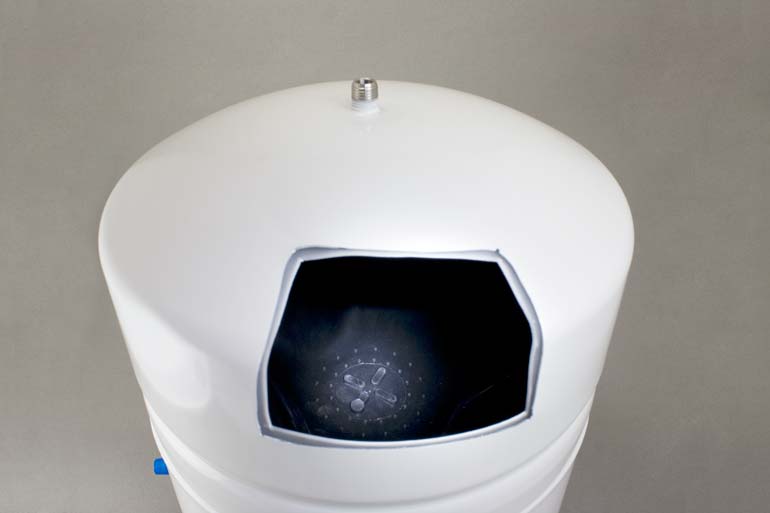
In the Aquasky tank the upper and lower halves of the tank are divided by a butyl partition, which can be seen through the window that has been cut from the tank. The upper portion of the tank contains a polypropylene liner that is visible in the picture. The water touches only the butyl partition on the bottom, the polypropylene liner, and the stainless tank neck. It does not touch the metal of the tank itself.
Beneath the bladder is an air-filled compartment that provides pressure to push the water from the tank when the faucet is opened. The small blue cap at the bottom left of the picture covers the valve where air is added to the tank.
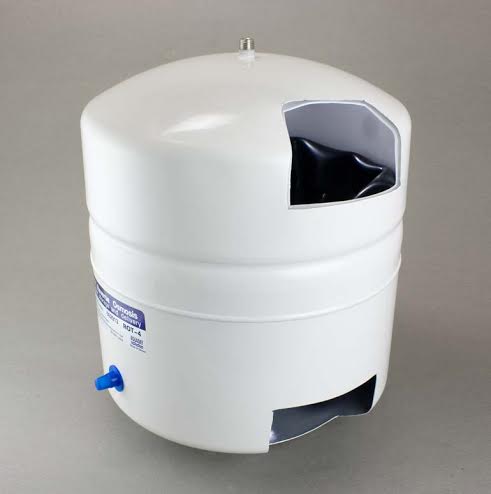
How to service your reverse osmosis tank.
Tools you'll need: bicycle pump, low pressure air gauge.
RO tanks are like auto tires: they lose air over time and you have to put more in. Too much is as bad as too little.The water is sitting on top of a rubber-like bladder inside the metal or plastic RO storage tank. There is a low-pressure air pocket under or around the bladder that pushes the water out when you open the faucet. If the air pressure is low, not all the water will be pushed out of the tank. If you put in too much air, you won't have enough space left for water. The object is to leave about 5 to 10 psi of air in the tank when the tank is empty of water.
How to do it:
Leave the inlet water to the unit on. Open the faucet to the RO unit and leave the RO faucet open during the entire procedure.
Water will come out of the faucet fast at first, then get slower until it goes down to a fast drip or a small stream.
(This is the water that the RO unit is producing. It's slow. That's why you need a storage tank in the first place.)
Now, try to lift the storage tank. If it's very light, the tank won't need much air. If it's heavy, you'll have a lot of pumping to do.
Attach a bicycle pump to the air valve on the tank. (It's on top of some tanks, on the bottom of others, and sometimes on the side.. You'll have look for it. It will probably have a cap on it that you'll have to remove.)
With the faucet still open, pump air into the tank. More water will start to leave the tank through the open ledge faucet. Continue to pump air into the tank slowly and steadily until all water is out of it.
The faucet will return to a fast drip or small stream.
Try to leave about 7 pounds of pressure in the empty tank. If you don't have a low-pressure gauge, guess. The exact amount isn't that critical. Don't over-air the tank, however, because you won't be gaining more water pressure; you'll just be leaving less room in the tank for water.
When the tank is aired, close the faucet and let the tank refill. You're through. You'll have enough water to use in a few minutes, but it may take a couple of hours for the tank to fill completely.
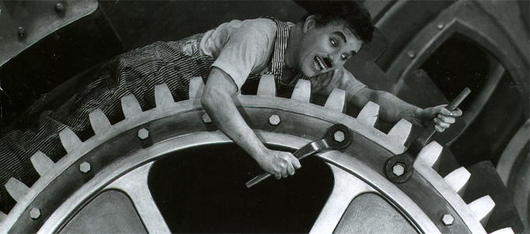
Please visit our RO Parts Page for tanks and accessories. We also have dedicated parts pages for countertop water filters, undersink filters, and aeration equipment. We stock parts for everything we sell.
Thank you for reading. Please come back next week.
Places to Visit on Our Websites in the meantime.
Garden Hose Filters. Don’t be the last on your block to own one.
Model 77: “The World’s Greatest $77 Water Filter”
”Sprite Shower Filters: You’ll Sing Better!”
An Alphabetical Index to Water Treatment Products
Our famous whole house Chloramine Catcher
Pure Water Occasional Archive: Sept. 2009-April 2013.
Pure Water Occasional Archive: April 2013 to present.
Write to the Gazette or the Occasional: pwp@purewaterproducts.com
Fair Use Statement
Please Visit
The Pure Water Gazette – now now with an up-to-the-minute feed of the latest water news.
The Pure Water Occasional
Pure Water Products
![occasionalbanner300[1]](https://ymlp.com/https.php?id=purewatergazette.net/blog/wp-content/uploads/2013/04/occasionalbanner3001.gif)
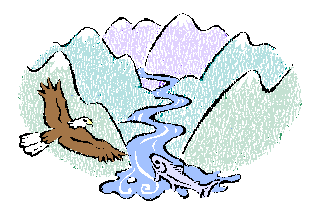



![algae[1]](https://ymlp.com/https.php?id=www.purewatergazette.net/blog/wp-content/uploads/2012/09/algae1.jpeg)






